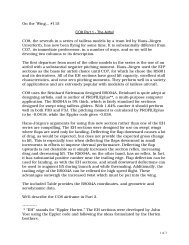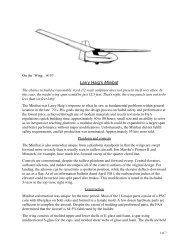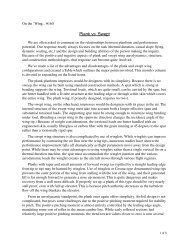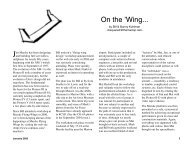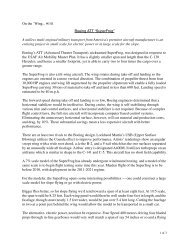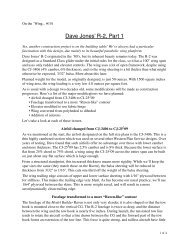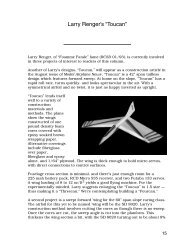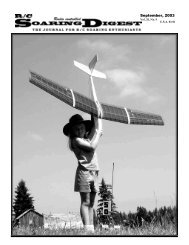Mar - Rcsoaring.com
Mar - Rcsoaring.com
Mar - Rcsoaring.com
You also want an ePaper? Increase the reach of your titles
YUMPU automatically turns print PDFs into web optimized ePapers that Google loves.
as epoxy resin. We use it extensively in<br />
<strong>com</strong>petition models of all types to gain<br />
structural strength and rigidity, plus it’s<br />
just cool! Understand, first, how this stuff<br />
is made. To make a very long story very<br />
short, you make this stuff by burning<br />
rayon and poly type fabrics down to<br />
nothing but the carbon that it is based<br />
on. It takes tremendous heat and some<br />
high pressure for this to happen, but<br />
in short that’s what they do. Carbon in<br />
itself is an atomically light material, but<br />
when <strong>com</strong>pounded with other elements,<br />
it be<strong>com</strong>es not only very dense but<br />
conductive to electricity. The conductive<br />
stuff is more or less what we end up<br />
using in our models. Because it is dense,<br />
and conductive, it does two things to<br />
the RF signals of our radio systems.<br />
The first is that it will block the signals<br />
from penetrating the material. It not only<br />
deflects the signal to a degree, but it also<br />
absorbs the signal using the electrical<br />
conductive properties it possesses. That<br />
second property of carbon fiber is one<br />
of the reasons it is used extensively in<br />
“stealth” aircraft. So, that being the case,<br />
you can now understand why it’s not<br />
good to place a carbon fiber structure<br />
between the radio Tx and the Rx. That<br />
signal just ain’t going to get through<br />
<strong>com</strong>pletely intact.<br />
Okay, so we have that fact of life down,<br />
and if you need to prove this to yourself,<br />
just try it out and you’ll see. It’s an<br />
easy experiment. Just remember that<br />
a ground range check proves nothing<br />
when it <strong>com</strong>es to carbon fiber. This leads<br />
us to our first experiment, only this one<br />
was originally done in 72-Mhz form.<br />
The situation is that we want to keep<br />
from having antenna wire hanging out<br />
of our wonderful, aerodynamically clean<br />
sailplanes, because the wire produces<br />
drag... and it looks ugly! At this time,<br />
most of the <strong>com</strong>petition planes were<br />
using a significant amount of carbon fiber<br />
(CF) in the construction of the fuselage to<br />
keep them light and also to give them the<br />
strength to withstand the typical “dork”<br />
landing.<br />
This is an Onyx 3.5 meter model and although the photo is small, you can clearly see<br />
the black, carbon fiber tail boom. In reality, the 72-Mhz antenna is wound around the<br />
tail boom on the outside of the boom. In this case, it did work, but the antenna suffered<br />
damage almost every time the plane landed as the fuselage scraped along the ground.<br />
<strong>Mar</strong>ch 2011 21



